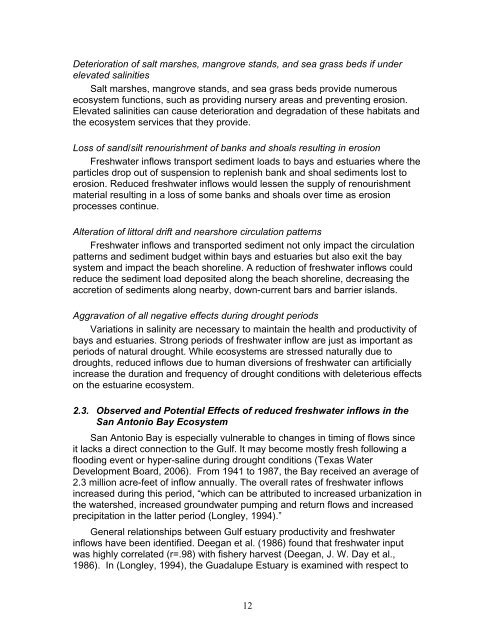The Economic Value of Water and Ecosystem Preservation
The Economic Value of Water and Ecosystem Preservation
The Economic Value of Water and Ecosystem Preservation
Create successful ePaper yourself
Turn your PDF publications into a flip-book with our unique Google optimized e-Paper software.
Deterioration <strong>of</strong> salt marshes, mangrove st<strong>and</strong>s, <strong>and</strong> sea grass beds if under<br />
elevated salinities<br />
Salt marshes, mangrove st<strong>and</strong>s, <strong>and</strong> sea grass beds provide numerous<br />
ecosystem functions, such as providing nursery areas <strong>and</strong> preventing erosion.<br />
Elevated salinities can cause deterioration <strong>and</strong> degradation <strong>of</strong> these habitats <strong>and</strong><br />
the ecosystem services that they provide.<br />
Loss <strong>of</strong> s<strong>and</strong>/silt renourishment <strong>of</strong> banks <strong>and</strong> shoals resulting in erosion<br />
Freshwater inflows transport sediment loads to bays <strong>and</strong> estuaries where the<br />
particles drop out <strong>of</strong> suspension to replenish bank <strong>and</strong> shoal sediments lost to<br />
erosion. Reduced freshwater inflows would lessen the supply <strong>of</strong> renourishment<br />
material resulting in a loss <strong>of</strong> some banks <strong>and</strong> shoals over time as erosion<br />
processes continue.<br />
Alteration <strong>of</strong> littoral drift <strong>and</strong> nearshore circulation patterns<br />
Freshwater inflows <strong>and</strong> transported sediment not only impact the circulation<br />
patterns <strong>and</strong> sediment budget within bays <strong>and</strong> estuaries but also exit the bay<br />
system <strong>and</strong> impact the beach shoreline. A reduction <strong>of</strong> freshwater inflows could<br />
reduce the sediment load deposited along the beach shoreline, decreasing the<br />
accretion <strong>of</strong> sediments along nearby, down-current bars <strong>and</strong> barrier isl<strong>and</strong>s.<br />
Aggravation <strong>of</strong> all negative effects during drought periods<br />
Variations in salinity are necessary to maintain the health <strong>and</strong> productivity <strong>of</strong><br />
bays <strong>and</strong> estuaries. Strong periods <strong>of</strong> freshwater inflow are just as important as<br />
periods <strong>of</strong> natural drought. While ecosystems are stressed naturally due to<br />
droughts, reduced inflows due to human diversions <strong>of</strong> freshwater can artificially<br />
increase the duration <strong>and</strong> frequency <strong>of</strong> drought conditions with deleterious effects<br />
on the estuarine ecosystem.<br />
2.3. Observed <strong>and</strong> Potential Effects <strong>of</strong> reduced freshwater inflows in the<br />
San Antonio Bay <strong>Ecosystem</strong><br />
San Antonio Bay is especially vulnerable to changes in timing <strong>of</strong> flows since<br />
it lacks a direct connection to the Gulf. It may become mostly fresh following a<br />
flooding event or hyper-saline during drought conditions (Texas <strong>Water</strong><br />
Development Board, 2006). From 1941 to 1987, the Bay received an average <strong>of</strong><br />
2.3 million acre-feet <strong>of</strong> inflow annually. <strong>The</strong> overall rates <strong>of</strong> freshwater inflows<br />
increased during this period, “which can be attributed to increased urbanization in<br />
the watershed, increased groundwater pumping <strong>and</strong> return flows <strong>and</strong> increased<br />
precipitation in the latter period (Longley, 1994).”<br />
General relationships between Gulf estuary productivity <strong>and</strong> freshwater<br />
inflows have been identified. Deegan et al. (1986) found that freshwater input<br />
was highly correlated (r=.98) with fishery harvest (Deegan, J. W. Day et al.,<br />
1986). In (Longley, 1994), the Guadalupe Estuary is examined with respect to<br />
12
















